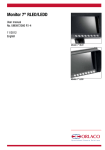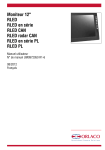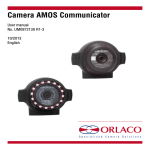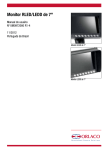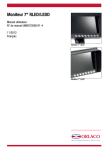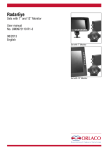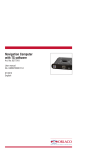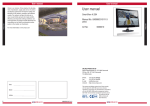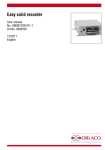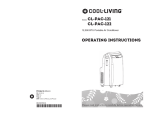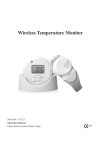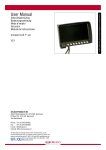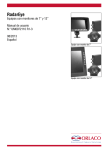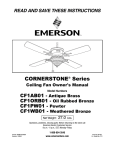Download UM0972050
Transcript
Monitor 12" RLED RLED Serial RLED CAN RLED CAN Radar RLED Serial PL RLED PL User manual Manual No. UM0972050 R1-6 08/2012 English Contents/Introduction User Manual Article numbers ORLACO Monitor 12” RLED 0207900 Monitor 12” RLED 0207910 Monitor 12” RLED Serial 0207920 Monitor 12” RLED CAN 0207930 Monitor 12” RLED CAN Radar 0207950 Monitor 12” RLED Serial PL 0207970 Monitor 12” RLED PL ORLACO Monitor 12” RLED, RLED Serial, RLED CAN, RLED Radar, RLED Serial PL, RLED PL Manual No. IM0972050, R1-6 ContentsPage 1. Quick Reference 2. Getting Started 3. Keyboard 4. Service menu 5. Operator menu 6. System overview 7. Overview of menus 8. Version details 4 6 7 10 16 18 20 21 Used abbreviations ABC = Auto Backlight Control AFZ = Auto Focus Zoom AGC = Automatic Gain Control BHO = Black Hot CCC = Compact Color Camera LUT = Look Up Table DDE = Digital Detail Enhancement FFC = Flat Field Correction FUS = Fusion I&F = Ice and Fire NTS = NTSC OSD = On Screen Display PIP = Picture in Picture PTZ = Pan & Tilt Zoom RB = Rainbow Stndrd = Std = Standard TCH = Tachometer TIC = Thermal Image Camera WHO = White Hot ZOO = Zoom Introduction Check with Orlaco which language versions are available. This manual contains user instructions. Used photographs and illustrations give general information and may differ from the products you use. Contact your Orlaco dealer if you have questions, additional information, or want to make changes that are not described in this manual. The camera and monitor systems from Orlaco comply with the latest CE, ADR, EMC and mirror-directive regulations. All products are manufactured in accordance with the ISO 9001 quality management system, ISO 14001 environmental management systems. See System Manual SM0973230 for installation. 2 UM0972050 R1-6 UM0972050 R1-6 3 Button 8 1. Quick Reference Button 8 Button 8 Keyboard Buttons 3 and 4, setting color saturation Button 7 Below is a brief description of the button functions. See sections 3 and 4 for a more detailed explanation. Button 7 Button 8 Button 7 Button 8 Button 3 Enter / standby Plus + select/setting Minus select/setting Option/previous menu Button 5 Brightness Contrast Button 4 Button 7 Button 6 Button 4 Button 3 Button 6 Auto backlight control Buttonmodes 3 Button 5 day/night Camera selection Button 8 Go to the next menu option or move left. Button 7,Button plus 8 Go to the previous menu option or move right. Button 2 Button 1 Button 7 Button 6,Button minus 7 Button 5 Button 4 Button 3 Button 4 Button 5,Button option/previous menu 6 Return to the previous menu. Button 8 Button 6 Button 6 Button 5 Button 7 Button 8 Press the contrast (3) and brightness (4) buttons simultaneously to enable the setting mode. Set the required color saturation using the minus and plus Button buttons. This setting must7be set separately for each camera. Button 8 Button 7 Button 2 Button 5 Button 8, enter Button 1, camera selection Button 2 Button 7 Button 4 Press the camera selection button once. The camera LED flashes to indicate that manual Button 6 camera selection is enabled. Use the minus and plus buttons to select the camera. Press Button 1 Button 1 Button 4 the button again to disable manual camera selection. Button 3 Button 6 Button 1 Button 1 Switch to Standby or in the menus, select or activate the chosen option. Button 8 Button 5 Button 8 Press this button to switch between the auto backlight day and night settings. Button 7 Button 2 Button 5 Button 2, auto3backlight control day/night settings Button Button 4 Button 2 Button 6 Button 3, setting the contrast Button 1 Button 4 Press the button once in order to enable the setting mode. Use the minus and plus buttons to set the required contrast. the button again to disable the setting mode. Button 3 Press Button 6 1 Button 5 Button 3 Button 3 Button 2 4, setting the brightness Button Button 5 Press the brightness button once in order to enable the setting mode. Set the required 4 and plus buttons. Press the button again to disable the setting brightness using Button the minus mode. n1 2 Button 7 Button 3 Button 4 Button 4 Button 4 Button 3 4 UM0972050 R1-6 UM0972050 R1-6 Button 3 Button 4 5 2. Getting started 2.1. Disclaimer When switching on the monitor for the first time, a disclaimer appears in English for 5 seconds (see Figure 1). Displayed text: Do not operate display functions during safety critical operations. Objects in the monitor are closer than they appear. If a different language is subsequently set, the disclaimer text appears in the set language. 2.2. Description of the keyboard Button no. 1 = Camera selection Button no. 2 = Auto LCD backlight control day/night settings Button no. 3 = Contrast Button no. 4 = Brightness Button no. 5 = Option/previous menu Button no. 6 = Minus selection/setting button (-) Button no. 7 = Plus selection/setting button (+) Button no. 8 = Enter/Standby 3. Keyboard Button 8 = Enter/Standby Button 7 = Selection/setting Plus(+) Button 6 = Selection/setting Minus(-) Button 5 = Option/previous menu Button 4 = Brightness Button 3 = Contrast Button 2 = ABC, day/night settings Button 1 = Camera selection 3.1. Button 1, camera selection Press the camera selection button (1) once (see Figure 2). The camera LED flashes to indicate that manual camera selection is enabled (see Figure 3). Press the button again to disable manual Button 8 camera selection. Use the minus and plus buttons to select the desired camera. The other buttons (3 = contrast, 4 = brightness and 3+4 = satura7 with the tion) can also be used and these functions can be Button adjusted minus and plus buttons. Disable these functions by reselecting a camera with the minus and plus buttons. Button 7 Button 8 = Enter/Standby Button 7 = Selection/setting Plus(+) Button 6 = Selection/setting Minus(-) Button 5 = Option/previous menu Button 4 = Brightness Button 3 = Contrast Button 2 = ABC, day/night settings Button 1 = Camera selection But Manual camera selection has priority over the scan function and the automatic camera selection. The button function can be disabled in the service menu via the option 'system settings → keyboard → Button 1 keyboard lock'. See system settings for more information (section Figure 2 4.3. on page 13). Figure 1 2.3. Language setting for the OSD (On Screen Display) menu Button 1 3.2. Button 2, auto LCD backlight control day/night settings The OSD menu language is set as English by default. If you would like to operate the OSD menu in a different language, open the service menu → system settings. See section 4 on page 13. The OSD menu is available in English, Dutch, German, French, Italian, Polish, Spanish and Swedish. See figure 4. For a compact camera, press this button to switch between: • The ABC mode • The LCD backlight day setting • The LCD backlight night setting TIC and AFZ cameras are exceptions. For these, pressing button 2 makes other functions available (see sections 3.8.1. and 3.8.2. on page 9). The ABC mode controls the backlight between a minimum (adjustable; see also under service menu on page 16) and a maximum level depending on the intensity of the ambient light. A light sensor on the keyboard measures the ambient light (see Figure 6). Button 1 Bu Figure 3 But Button 2 Figure 4 Button 1 Button 1 In the day and night mode the brightness of the backlight can be manually set using the minus and plus buttons (the settings are saved). These settings are not camera dependent and therefore apply for all cameras (see Figure 5). Figure 5 Button 8 Button 7 Figure 6 6 UM0972050 R1-6 UM0972050 R1-6 7 3. Keyboard 3. Keyboard Button 7 3.3. Button 3, setting the contrast Press the contrast button (3) once to enable the setting mode (see Figure 7). Use the minus and plus buttons to set the required contrast. This setting must be set separately for each camera. 3.4. Button 4, setting the brightness 8 PressButton the brightness button (4) once to enable the setting mode (see Figure 8). Set the required brightness using the minus and plus buttons. This setting must be set separately for each camera. Button 7 Button 7 When in normal image mode, the following quick settings are available as shortcuts: 3.8. Quick settings Button 8 = Enter/Standby Button 7 = Selection/setting Plus(+) Button 6 = Selection/setting Minus(-) Button 5 = Option/previous menu Button 4 = Brightness Button 3 = Contrast Button 2 = ABC, day/night settings Button 1 = Camera selection 3.8.1. TIC camera Button 7 3.5. Buttons 3 and 4, setting color saturation Button 4 Press the contrast (3) and brightness (4) buttons simultaneously to enable the setting mode. Set the required color saturation using the minus and plus buttons. This setting must be set separately for each camera. 3.6. Locking buttons 2, 3 and 4 These buttons can be locked in the service menu (section 4.3.3. keyboard, see page 13). Button 2 Button 2 The TIC camera video standard and spot meter settings are only accessible via the camera menus. There are no keys for direct access to these settings. See page 10, section 4: service menu, camera settings. Button 1 8 When a TIC camera is selected and button 2 (Figure 12) is pressed, then Color LUT and DDE quick settings are enabled (indicated by illuminated button Button 5 2). Using the minus button (button 6), the Color Button LUT settings (WHO, BHO, FUS, RB, I&F) can be selected (see 8 Figure 11). Using the plus button (button 7), the DDE settings (OFF, LOW, MED, HI) can be selected. If button 2 (Figure 12) is pressed for more than 3 seconds, then the Button TIC camera performs a FFC (Flat Field 7Correction) cycle. Figure 10 If an AFZ camera Button 6 is selected and button 2 is pressed (Figure 12), then the zero lux and backlight functions of the AFZ camera are enabled/disabled. Figure 7 • Single scan sequence If the option button a CCC1is selected (see Button(5) 1 is pressed andButton camera settings on page 10), then the LEDD monitor generates a single scan (not continuous) of multiple connected cameras in Figure 8 a sequence (using the set time interval. The scan time must only be set if the main scan is started and then stopped again). See Button 3 page 15, scanning. • Connection with an AFI/AFZoom camera This option enables the zoom function (indicated by the illuminated button). The zoom factor can be changed using the plus Button 2 and minus buttons. • Connection with a TIC camera Figure 9 Zoom factors for a TIC camera are: 1x (standard display), 2x and 4x. When zooming out to 1x, the pan/tilt function is set at the utton 1 Button 1 starting point. Button 4 • Connection with a PTZ camera If pan/tilt is enabled and the option button (button 5) is pressed several times, then the ZOOM, PAN, TILT sequence is run Button through (see Figure 10). The minus and plus3buttons are used to activate the ZOOM, PAN or TILT movement (PAN and TILT for a TIC camera only work if the digital zoom is 2x or 4x). Button 6 3.8.2. AFZ camera Button 3 Button 5 3.7. Button 5, option button Button 8 Button 8 Button 4 Figure 11 But 3.8.3. CCC camera Button 8 2 (Figure 12) switches If a CCC is selected, then pressing button between all backlight settings for the entire system (DAY, NIGHT, ABC). See section 3.2. Button 2 Figure 12 Button 7 Button 1 Button 1 Button 6 Button 5 Button 3 UM0972050 R1-6 UM0972050 R1-6 Button 4 9 Button 3 Button 4 4. Service menu 4. Using the service menu 4. Service menu Button 6 4.1.9. Vertical line mark Button 5 Enable this option to show a reference line. The reference line is displayed as a vertical green line. See Figure 40 on page 17. 4.1.10. Marker position Button position 4 Adjusts the vertical of the reference line. This can be set between 38 and 63. The left and right sides swap position depending on the settings of the camera mirror-image function. 4.1.11. Graticule Button 8 Button 3 This option shows a graticule for a rearview camera on the monitor. See Figure 40 on page 17. 4.1.12. Camera type 4.1. Camera settings Button 2 Button 8 the camera type that is connected. The special features of Select Button 7 Select camera settings. Press enter to open the 'Camera settings' menu. that camera type will then become available. The camera types that Use the minus (6) and plus (7) buttons to select which camera to concan be selected are: figure. Then confirm this selection by pressing the enter button (8). The AFZ: Enable this option if an AFI/AF zoom camera is connected. If yellow cursor is now activated in the list of items. Use the minus Button 6 Button 7 Button 1 (6) and Button 1 AFZ is selected, the backlight, zero lux and stabilizer options are plus (7) buttons to select the item to adjust and then confirm this selecFigure 13 enabled. tion by pressing the enter button. If the selection is an on/off switch, you Operation of the zoom function: can choose between on and off. If the selection is a number, you can Button 6 Button 5 - Enable the zoom function. The zoom function is change the value using the minus (6) and plus (7) buttons. Save theButton new 5 disabled if the button is pressed again. settings by pressing the enter button (8). Button 6 - Zoom out. Button 7 - Zoom in. 4.1.1. Mirror Button 4 Button 5 TIC: Enable this option if a Thermal Image Camera (TIC) is conEnable this option to reverse the image (left/right). Figure 14 nected. If TIC is selected, then the video standard, color LUT, TIC 4.1.2. Upside down DDE and spot meter options are enabled. This option flips the image (upside down). Button 3 Button 4 CCC: Enable this option if a Compact Color Camera (CCC) is con4.1.3. Brightness nected. The setting for the brightness of the monitor. For direct button 4.1.13. Video stndrd operation: Button 4. Video standard: The camera type must be set to TIC. Select the ButtonContrast 2 Button 3 4.1.4. standard video output for the camera: PAL or NTSC (NTS). The setting for contrast on the monitor. For direct button operation: 4.1.14. Backlight Button 3. Figure 15 This option corrects the background light in order to improve the 4.1.5. Saturation on 2 screen display of dark objects in bright/lit surroundings. This option The color saturation setting for the camera image. For direct button is only available if an AFZ camera is connected to a serial 12” monioperation: Buttons 3+4. tor. For direct button operation: Button 2. 4.1.6. Switch delay Enable this option if the switchwire is controlled by an intermittent signal (e.g. from an indicator light). 4.1.7. Horizontal line mark Figure 16 Enable this option to show a reference line. The reference line is displayed as a horizontal green line. See Figure 40 on page 17. 4.1.8. Marker position Adjusts the vertical height of the reference line. 0 corresponds to the top edge of the monitor and 100 to the bottom edge. To open the service menu, simultaneously press the camera selection button (1), the minus button (6) and the plus button (7) (see Figure 13). The display (see Figure 14) will appear. The following buttons are used to navigate through the menus: 5 - Option/previous menu: Return to the previous menu 6 - Minus: Go to the next menu option 7 - Plus: Go to the previous menu option 8 - Enter: Select or enable the chosen option Button 8 = Enter/Standby Button 7 = Selection/setting Plus(+) Button 6 = Selection/setting Minus(-) Button 5 = Option/previous menu Button 4 = Brightness Button 3 = Contrast Button 2 = ABC, day/night settings Button 1 = Camera selection Button 3 10 Button 3 Button 4 Depending on the choice of camera type (see Figure 17), the settings marked in blue will or will not be available. Button 3 Button 4 Button 4 UM0972050 R1-6 UM0972050 R1-6 Figure 17 11 4. Service menu 4.1.15. Zero lux Enable this option to improve the light sensitivity of the camera in dark surroundings. This option is only available if an AFZ camera is connected to the monitor 12” serial. 4.1.16. Stabilizer This option enables the stabilizer function, if the camera has one. This option is only available if an AFZ camera is connected to a serial 12” monitor. 4.1.17. Color LUT (look up table) The camera type must be set to TIC. Select the color palette to be used to give the correct color temperature. Select from WHO (white hot), BHO (black hot), FUS (mixed), RB (rainbow) and I&F (ice and fire). The AGC (automatic gain control) is automatically set for the WHO, BHO, FUS and RB settings. 4.1.18. TIC DDE (TIC digital detail enhancement) Possible settings are: OFF, LOW, MED and HI. Select the desired degree of image enhancement. 4.1.19. Spot meter Only works if TIC is selected as the camera type (see section 4.1.13. on page 11): OFF (spot meter off) B C (bar in Celsius) B F (bar in Fahrenheit) N C (number in Celsius) N F (number in Fahrenheit) BNC (bar + number in Celsius) BNF (bar + number in Fahrenheit) 4.1.20. Pan/tilt Enabling the pan/tilt function makes standard pan and tilt operation possible (option button = button 5). It is possible to use digital pan/ tilt when the TIC image is zoomed 2x or 4x. 4.1.21. PIP/Split Screen Set this option to ON to enable Picture In Picture or Split Screen. Visible only when the camera switch is set to 2C or 4C, see section 4.3.8. PIP Mirror Select this option to see the monitor in mirror mode. Camera No. Select which camera should be shown in the PIP or Split Screen window. Width, Height, Horizontal position, Vertical position of the PIP or Split Screen window can be adapted. See figure 19 and 20. 4. Service menu 4.3. System settings (see Figure 22) 4.3.1. Language See Figure 23. This option opens the language selection menu. The selected language will be used for all OSD menus. The OSD menu is available in English, Dutch, German, French, Italian, Polish, Spanish, Swedish. 4.3.2. On Screen Display (OSD) This option opens the OSD settings menu. See Figures 24. The following can be set in this menu: OSD time-out Sets the time (in seconds) that the OSD (camera number/name, top left) appears on the monitor. Select 'Off' to disable this and 'On' to have this permanently enabled. OSD menu help This function enables or disables the automatic text messages of the OSD help menus. If enabled, help messages automatically appear in all menus after 10 seconds of inactivity. 4.3.3. Keyboard This option opens the keyboard menu. See Figure 26. This menu has the following 3 options: Keyboard lock This option opens the settings menu for the keyboard lock. It is possible to lock various functions in order to prevent any unwanted changes. See Figure 27. The keyboard sound and beeper volume functions are not available on all Orlaco monitors. 4.3.4. Power settings See Figure 28. This menu has the following 2 options: Standby mode There are three available choices — use the minus and plus buttons to select the various functions. MNU = With this setting you access the operator menu via the enter button (8). Select the required setting. IMM = Immediate standby 2S = Standby after a delay of 2 seconds Standby, camera off If this option is enabled, the camera power is off during standby. Figure 18 Figure 19 Figure 20 Figure 21 Figure 23 Figure 24 Figure 26 Figure 27 Figure 28 4.2. Camera tags In this menu, names can be given to the camera inputs. See Figure 21. The number of inputs depends on the video switch type that is set (see section 4.3.8. on page 15). 12 Figure 22 UM0972050 R1-6 UM0972050 R1-6 13 4. Service menu 4. Service menu 4.3.5. CAN bus See Figure 29. This option opens the CAN bus menu. This menu has the following 4 options: CAN protocol This option selects the signal, or CAN protocol, that the monitor uses. By default this is Orlaco CAN protocol 1. For the Orlaco Radar system, Orlaco CAN protocol 6 must be set. Other protocols are customer-specific. The CAN speed is automatically adjusted, but it Figure 29 can also be set manually once the protocol has been selected. Set CAN-ID The Orlaco CAN protocol has an ID (default 0) to control multiple monitors via one CAN bus. The ID is inactive when the text is blue and becomes active when the protocol is set to 1. The CAN-ID can be set from 0-15 where 0 is the default value. CAN speed This option selects the bit rate of the CAN bus. Available options are: 100, 125, 200, 250, 500 and 1000 kbit. Main terminator Enable/disable the 120 Ω terminator (CAN or RS485) between Rx and Tx. AUX terminator Enable/disable the 120 Ω terminator (CAN or RS485) between AUX1 and AUX2. 4.3.6. LCD backlight This option opens the backlight submenu for the monitor 12”. See Figure 30. This menu has the following 4 options: LCD backlight mode This option enables automatic backlight control (ABC). The monitor Figure 30 automatically adapts its brightness to the ambient light. Metering sensor on the keyboard. If required, a specific day or night brightness can be manually set. ABC minimum level This setting determines the minimum brightness the ABC can use when there is low ambient light. LCD backlight day This option allows the day brightness setting to be manually adjusted (50–100%). LCD backlight night This option allows the night brightness setting to be manually adjusted (0–50%). 4.3.7. Scanning This option opens the camera scanning submenu. See Figure 31. This menu has the following options: Scan sequence This option selects the cameras from which images Figure 31 are to be shown in sequence. Scan interval This option selects how long a camera image is displayed. 14 4.3.8. Camera switch This option configures the type of video switch that is used. See Figure 32. 'OFF' if no camera switch is used → 1 camera system. '3C' for an external camera switch → 3 camera system. '2C' if a 2–4 camera cable is used → 2 camera system. '4C' if a combination of internal and external switches and a 2–4 camera cable are used → 4 camera system. 'QUA' for a quad system, only in combination with the quad switch. With the settings 2C and 4C the PIP or Split Screen function can be used, see also chapter 4.1.21. 4.3.9. AUX wire function Defines the function of the AUX1 & AUX2 switching wires (grey and yellow). Select TCH for the tachometer function (Tacho to AUX1 and hand brake to AUX2) or ZOO for the camera zoom function (only available in combination with an auto focus camera). Use in this case the AUX1 and AUX2 switching wires to zoom in and out. Switch AUX to OFF to use the gray wire as trigger wire for the 4C system. Select KEY to block the keyboard fully by activating the wire AUX1. 4.3.10. Default settings This option opens the menu to restore the factory default settings. Select the number of the factory settings that you require (1 = default Orlaco settings). You can choose between 30 sets of default settings. Contact ORLACO for further information. Select the option 'Restore defaults' to restore the factory settings. Warning: All user settings are lost when the factory defaults are restored! 4.3.11. External device configuration This option opens the configuration menu for an external device. Only use this option if a device is connected that has its own OSD (Multiview, Spectrum Scanner, etc.). Exit the menu by pressing the option button (5) for 3 seconds. Figure 32 Figure 32a Figure 33 Figure 34 4.4. Info This user manual describes the functions of the software version indicated on this display (see Figure 35). Figure 35 UM0972050 R1-6 UM0972050 R1-6 15 5. Operator menu 5. Operator menu 5. Using the operator menu The operator menu is not available by default due to the keyboard lock. To disable the lock, refer to system settings on page 13. Press the minus and plus buttons simultaneously to open the operator menu. The following buttons are used for navigation: 5 - Option/previous menu: Return to the previous menu 6 - Minus: Go to the next menu option 7 - Plus: Go to the previous menu option 8 - Enter: Select or enable the chosen option Button 7 Button 8 Vertical Horizontal and vertical Button 7 Figure 36 Button 5 Enable this option to show a reference line. The reference line is displayed as a horizontal green line. See Figure 40. Line position utton 2 Button 3 Adjusts the vertical height of the reference line. 0 corresponds to the top edge of the monitor and 100 to the bottom edge. Vertical line mark Enable this option to show a reference line. The reference line is displayed as a vertical green line. This option is not available on all 12” models. See Figure 40. Line position Adjusts the vertical position of the reference line. This can be set between 38 and 63. The left and right sides swap position depending on the settings of the camera mirror-image function. Graticule This option shows a graticule for a rearview camera on the monitor. See Figure 40. 16 Graticule Button 8 Button 6 This option opens the language selection menu (see Figure 38). The selected language will be used for all OSD (On Screen Display) menus. The OSD menu is available in English, Dutch, German, Button 5 4 French, Italian, Polish, Spanish andButton Swedish. 5.2. Camera settings (see Figure 39) Horizontal line mark3 Button 4 Button Horizontal Figure 40 The following settings can be adjusted (see Figure 37): Language Camera settings Set video channel 5.1. Language Button 8 = Enter/Standby Button 7 = Selection/setting Plus(+) Button 6 = Selection/setting Minus(-) Button 5 = Option/previous menu Button 4 = Brightness Button 3 = Contrast Button 2 = ABC, day/night settings Button 1 = Camera selection Button 6 Figure 41 Figure 37 5.3. Video channel settings See Figure 41. This option sets the video channel for the Orlaco Spectrum Scanner (see Figure 42). The following options are available: CH0 = channel 0 to CH7 = channel 7 AUT = automatic See the Spectrum Scanner IM0004060 installation manual for descriptions of these channels. Figure 38 Figure 42 Figure 39 UM0972050 R1-6 Button 3 Button 4UM0972050 R1-6 17 6. System overview 6. System overview One camera system Three Camera System With Picture in Picture Camera CMOS Monitor 12” Monitor 12” Molded Y-Cable Camera AFZ Power Power Camera CMOS Camera CMOS Switcher Two camera system With Picture in Picture Monitor 12” Four Camera System Molded Y-Cable With Quad picture Camera CMOS Monitor 12” Power Camera AFZ Camera CMOS Power Multiview box Camera CMOS Camera CMOS Camera CMOS System options: 18 Indicated are some basic examples, there are more combinations possible, ask ORLACO for the possibilities. UM0972050 R1-6 UM0972050 R1-6 19 7. Overview of menus 8. Version details Version R1-0. First release, August 2012. Version R1-1. Chapter 4; menu and text changes, Chapter 6; System overview changed, Chapter 7; Menu and text changes, October 2012. Version R1-2. Monitor Article number added, page 3; January 2013. Version R1-3. PIP Mirror added, CAN-ID added, August 2013. Version R1-4. Explanation splitscreen in menu added, Chapter 4.1.21.; February 2014. Version R1-5. Barcode added, September 2014. Version R1-6. Monitor Article number added, page 3; January 2015. Standby menu Enter Standby menu Standby Info Display is on but there is no picture Software information Operator menu The operator menu is not available by default due to the keyboard lock. Minus- and Plus buttons Operator menu Language Camera settings Set video channel English, Dutch, German, French, Italian, Polish, Spanish, Swedish. Horizontal Marker, Marker position, Vertical Marker, Marker position, Graticule CH0, CH1, CH2, CH3, CH4, CH5, CH6, CH7, AUT Service menu Camera- + Minus- and Plus buttons Service menu Camera settings Camera tags System settings Info Mirror, Upside down, Brightness, Contrast, Saturation, Switch delay, Hor. Marker, Marker position, Vert. Marker, Marker position, Graticule, Cinema mode, Camera type, Video standard, Backlight, Zero Lux, Stabilizer, Color LUT, TIC DDE, Spot meter, Pan/Tilt, PIP (See below) 1, 2, 3 System settings Language On screen display Keyboard Power settings CAN-bus LCD-Backlight Scanning Camera switch AUX Wire function Default settings Ext. device config English, Dutch, German, French, Italian, Polish, Spanish, Swedish. On screen display OSD timeout OSD menu help ON, OFF, 30sec, 10sec, 3sec ON/OFF Keyboard QUA, 4c, 2c, 3c, OFF OFF, TCH, ZOO, KEY Keyboard lock Keyboard sound Beeper volume OFF, K+A, ALM, KEY 0-100 positions Keyboard lock Default settings Select default Restore defaults ON/OFF ON/OFF ON/OFF ON/OFF ON/OFF Standby menu Operator menu Camera switch Camera settings Standby 1-21 Power settings Standby mode Standby camera off IMM, MNU, 2sec ON/OFF CAN-bus PIP PIP Mirror Camera No. Width Height Hor. pos. Vert. pos. (See Service menu - Camera settings) CAN-protocol CAN-speed Set CAN-ID Main terminator AUX terminator OFF, 1-6 positions 1M, 500, 250, 200, 125, 100 0 - 15 ON/OFF ON/OFF LCD-backlight LCD-backlight mode ABC Minimum level LCD-backlight day LCD-backlight night ABC, NIT, DAY 0-50 50-100 0-50 Scanning Scan sequence Scan interval 20 OFF, 1-2, 1-2-3 2s, 5s, 10s UM0972050 R1-6 UM0972050 R1-6 21 22 UM0972050 R1-6 UM0972050 R1-6 23 ORLACO Orlaco is a Manufacturing company that specializes in making cameras and monitor systems for commercial vehicles, fork-lift trucks, cranes, off shore and maritime. Our objective is to design and produce camera systems for the professional market that improve the drivers’ view and increase operating efficiency. At our facility in Barneveld we locate our design, manufacturing, warehousing and service department. Vision is our mission®. Orlaco therefore deploys the development, manufacture, supply and service of camera and display systems that will improve safety and efficiency of all vehicles, machinery and vessels. Our systems give the end user a view on each blind spot and will create comfort and improved working conditions. Our active approach will support market demands and innovations and will lead to enthusiastic ambassadors in the market; our customers. For more information: www.orlaco.com ORLACO PRODUCTS BV Albert Plesmanstraat 42, 3772 MN Barneveld PO Box 193, 3770 AD Barneveld The Netherlands Phone: +31 (0) 342 404555 E-mail:[email protected] Internet:http://www.orlaco.com














